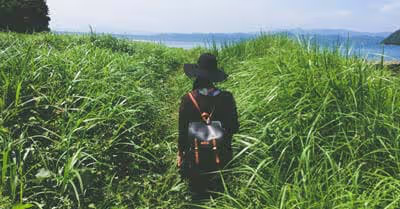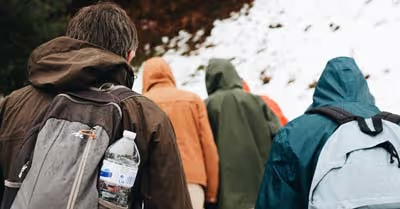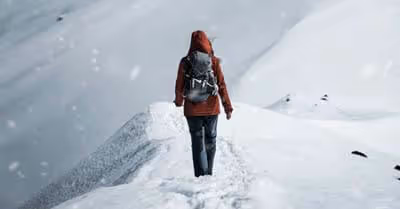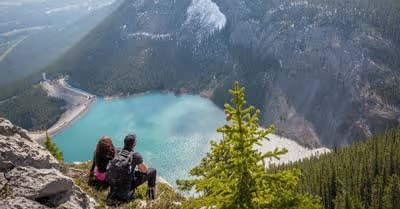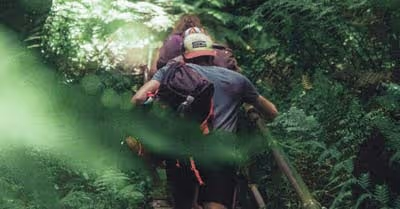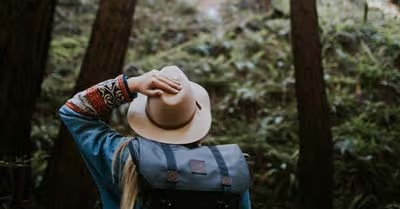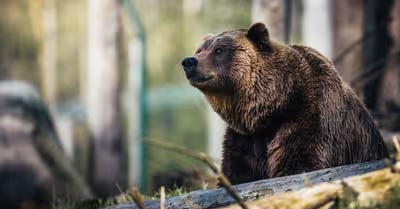Table of Contents
Hiking in Utah
When hiking in Utah it is important to ensure that you let someone know where you are going. The state is pretty big, mostly forest and national parks, and has a relatively tiny population. If you are hoping someone will just stumble upon you during your hike you may be disappointed, This is a danger that many people don't consider. If you are planning on going on a solo hike, I would suggest that you not only warn people where you are going but bring a Sat Phone with you. Utah is home to endless national parks, as mentioned above, most of them offer a variety of hikes of varying difficulties. If you are looking for a family-oriented state, it doesn't get much better than Utah. Not only are there a plethora of kid-friendly hikes, but the people and the general sense of community are safe and welcoming. If you are planning on visiting Utah in the winter for hiking, well, let's just say you better bring a big, fluffy, coat.
The climate in Utah
Utah is a very strange place. The entire community was based around settling a salt lake. Which, if you have even a basic understanding of how plants and animals work, is essentially useless for drinking and agriculture. Their water source was as useless as the ocean, without the added benefit of having the ability to fish it. Then, you must consider that Utah is a dessert. No, not like the Sahara, it isn't entirely made of sand and cacti with camels roaming freely. Technically, a desert is anywhere that doesn't have more than 10 inches of rain a year. By this definition, this state that has very little stereotypical "deserts" is one of the biggest deserts in the world. What this means is that in the summer, Utah will be hot and dry. Arid even. In the winter, you might expect no rain. What you are going to get instead is vast, vast, amounts of snow and hail. Snow does not count in the metric for deserts if it did Utah would NOT be considered a desert. If you are planning on visiting in winter, bring a coat, if you plan on hiking in winter. You better bring your A-game or you might not make it back down the trail.
Deadly wildlife to beware of in Utah
Utah may seem the perfect blend of man's determination to settle anywhere and mother nature's ambition, but there are plenty of deadly secrets to the wilderness of this great state. Many of them furry! You might not equate Utah with deadly spiders, but you should. The Black Widow can be found throughout the state, especially in the wooded areas. Bears are not uncommon and moose run rampant. A baby moose might seem like the golden photo opportunity, but I can assure you it isn't worth it. Momma moose will run you down and stomp you out faster than you can even think about running away. A full-grown moose makes a horse look tiny! Rattlesnakes are also prominent, especially in fields and parks. Which, Utah has many of, of course.
What do I need to bring with me?
If you are hiking through the Utah wilderness you must remember to dress for the occasion. A winter snowstorm can be deadly, you have likely never felt as cold as you will in the dead of winter on an overcast day in the Utah Rockies. Unless you are a local, that is. I would also suggest that you invest in a Sat Phone or at the very least a decent GPS. Getting lost in Utah can be a death sentence, it could be weeks before someone notices you are missing let alone finds you. Hiking poles are a little bit controversial, they can be beneficial but do carry some risks. If you fall with hiking poles on, you greatly increase your risk of injury. At the same time, if you are wearing hiking poles you greatly reduce your risk of falling when traversing very steep and slippery terrain. Since Utah is prone to snow, and very low temperatures, it is also prone to ice. And lots of it! Hiking poles with sharp tips can help you break up ice and give you two extra points of contact with the ground. You don't have to bring hiking poles, but its probably a good idea.
The 10 of the best hikes in Utah
There are more hiking trails in Utah than could have possibly been contained in this article, comprehensive as it may be! That meant picking the best trails was a little tricky. Some that very nearly made the list might be the best trail in the state, in other states. But that isn't the case in Utah. The competition was fierce! All of these hikes are somewhat achievable for a range of skill levels, it just might take the beginners a little longer. No worries there, Slow and steady wins the race and all that jazz. These hikes are listed in no particular order other than difficulty, it is up to you to decide which hike would best suit your wants, needs, and most importantly - ability:
#1 Fairyland Loop
The Fairyland Loop is a great one to bring the kids with you. It is reasonably flat, the terrain isn't too rocky (not too rocky for children, anyway) and the hike itself isn't overly long. Since it is a loop, you also don't run the risk of getting lost. if you do manage to somehow get lost, that is more concerning than the matter of being lost itself. The loop is named for the beautiful array of colors you will see as you make your way around it. This 8-mile hike isn't easy, perse, but it is doable. You can get it done within the day quite comfortably if you set off in the morning and don't expect to return until the afternoon. Make sure you bring enough water for you, no matter how "easy" this hike is - you will still burn through your water like nobody's business. If you listen to the wind from the top of the ridges along this trail it almost sounds like someone blowing on a reed pipe, the oohs and ahhs as the wind makes its way through the twisting and turning canyon is rhythmic, yet chaotic, and entirely beautiful. The Fairyland Loop can be found in Bryce National park.
#2 Delicate Arch
This hike is a little shorter, at just 3 miles (there and back) making it doable in just a few hours, even beginners could make the trek in less than a morning. The incline is quite steep, which is why this hike has been marked as more difficult, but I can assure you it is more than manageable. The hike is named after the arch itself, which is a beautiful orange stone, stretching a fair way from point to point with a remarkable gap in between. Have no fear, that arch isn't coming down anytime soon! You can get close enough to take some cool forced perspective photos, but you shouldn't touch the arch itself. The arch makes a wonderful natural frame for the surrounding mountain range. This hike is great for everyone, especially photographers. Or painters, if you like to stick to the classics. Unsurprisingly, you can find the Delicate Arch in the aptly named Arches national park.
#3 Queens Garden
The Queen's garden is a nice change of pace from the Fairyland Loop. This trail follows much of the same route but is only about 25% as long. You aren't going to get as much of the enjoyment out of hiking, but the result is similar. These two trails almost juxtapose each other, so doing one and then the other can be even more enjoyable than doing either-or. The Queen's garden follows old Navajo trails and takes you through a natural stone amphitheater. This trail is probably the most jam-packed in terms of sights, you will twist and turn, wind and twirl your way through the canyon and along a few short ridges, giving you glimpses of most of the surrounding areas. If you only have a short time spare to enjoy your hike, and want to see as much as you possibly can - this is the one for you. In terms of difficulty, the hike itself isn't overly hard. It is quite steep and can be slow going when trying to find the right footing, but other than that you should be good to go. Take your time, and perhaps bring hiking poles with you, and you are sure to be fine. The Queen's garden can be found in Bryce National park.
#4 The Narrows
The Narrows, in my opinion, is the highlight of Zion national park. This hike will take you up through the hills and down through the gullies that make up this beautiful park. You will follow the trail of the natural water flow, making your way downstream as if you were the water itself. Luckily, or unluckily, sometimes the water is still there. If you are planning on going in summer, and the streams are flowing, this can be an amazing way to keep cool on the trail. Just don't lose your footing! This river hike is about 8 miles long, which might not sound like a lot - after all, the first hike on this list was 8 miles long too! Yes, but that hike wasn't through a river. Walking through water is hard work. The resistance means you are putting twice as much effort into each step, your feet will drag, any bag you carry will drag you down into the water making the trek even more difficult. Now imagine how much harder it will be going back upstream! This hike is only available certain times of the year, so check with Zion National park before you go if you are betting on it being open. You can find information about this hike, all the other hikes, and any other events or warnings about the happenings of Zion national park on the park's website. You can find that websitehere.
#5 Angels Landing
Angels landing is very aptly named. It was named for the high, violent, upwards slope of the central ridge top. This hike is a popular tourist destination, for a good reason. It is beautiful. Since the hike is so popular, you can rest assured that you are very safe on the trail. The chances of you wandering astray and being lost for days are pretty slim. This is good for nervous beginners, but not ideal if you are a lone wolf when it comes to hiking. The best way to avoid the crowd is by starting your trek very early morning or towards the mid-afternoon. You may need to bring a flashlight, especially if you are electing to choose the mid-afternoon hike. This trail may be pretty safe, that doesn't mean navigating it in the dark is going to be easy. This hike is just 4.1 miles long, so you certainly can leave until late and still make it back at an acceptable time. This might be a task for the more experienced hikers, though. Angels landing can be found in the Zion National park, along with a few others on the list. If you are hoping to do more than one, this should perhaps be one of them.
#6 The Wave
The wave is one of the most surreal things you will see during your time in Utah. The wave refers to the swept sandstone that has, over time, developed a wave-like pattern due to natural erosion from wind and to a lesser extent rain. The wave is very beautiful but unfortunately doesn't have the same effect it does in person via photograph. The very best photographers will be able to make the wave work for them, the rest of us will have to do our best to commit it to memory! The wave is easier on the legs for those hikers who struggle with steep inclines, it stays at a pretty steady elevation never going above 400 feet. Much lower than the majority of alternative hikes. But, the hike is also 4 miles long. Which can be quite a challenge in the dry summer heat. Unfortunately, due to the waves national heritage status, you will need to purchase a permit if you wish to hike the trail, the permits can be purchased online. The wave is deep in the Vermilion Wilderness, you will have to drive for over an hour down a pretty rough dirt track before you get there. The roads are also prone to flash flooding, though it is unlikely to do so during the middle of summer. This is when it is best to visit, the bright sunshine reflecting off the waves tends to bring them to life.
#7 Mount Timpanogos
This hike had to make the list, where it ended up on the list is tied entirely to its steepness. On this 14 mile hike you will climb over 4300 feet, I will let you do the math on that one to work out the gradient. I'll give you a clue, very steep! A 14-mile hike alone is nothing to turn your nose up at, the massive increase in elevation takes things to a whole other level. The mountain resides at a location of its own, it is not attached to any of the national parks as so many of the other hikes are. This mountain is the highest in Utah, it will offer you unparalleled views of the whole state. If you want to see Utah in all its glory, being atop Mount Timpanogos at sunrise or sunset is the way to do it. Why not both? Hiking the trail is free, but parking costs 6 dollars. A small price to pay for such a once in a lifetime hiking opportunity. Besides, that money goes to maintaining the mountain. It's a win-win. If you are hoping to see wildlife, the kind of wildlife that isn't a threat to you particularly, this is the way to do it. This mountain is swarming with mountain goats, you will see them all around you so long as you don't make too much noise on the trail. If you are hoping to spot these wonderful goats, make sure to look above you as well as below. Mountain goats can be spotted here high, high, up on the cliff face. The goats will explore every nook and cranny of this mountain as they want to do!
#8 The Buckskin Gulch
The Buckskin Gulch can be found in the Vermilion wilderness, the trail starts at the entrance to the area so you can't miss it. The wilderness is forthcoming, you don't start there! This hike requires a day permit, and you will need the whole day, as the hike is just shy of 16 miles. If you do the whole hike, it is 32 miles if you plan on going there and back which would of course require a multi-day permit. Don't worry, the permits can be purchased from the beginning of the trail. You can't miss it. The trail itself is a long slot canyon. This means the trail is very long, very narrow, and overbearing as can be. It is arduous and torturous making your way through this long trail. Not to say it isn't beautiful, it is, but its hard work. It is so long that most people elect to hike just a short part of the trail, before ducking off into alternate routes. I would recommend sticking with it. It's pretty quiet, since most people only hike part of it, and completing it is a big achievement. Buckskin Gulch is the longest slot canyon in the whole world.
#9 The Gold Cathedral
This hike has been positioned towards the end of the list mostly because of its length. It is just over 9 miles long, which can be more than your average hiker will be willing to face all in one go. The going can get pretty tough towards the end, so only undergo this hike if you are sure of your abilities and general fitness. Since the hike is so long, you are going to need to bring a fair amount of gear with you. lots of water, food, some spare socks, a first aid kit, and perhaps some sports drinks. The hike is so long that you are best to start it early in the morning, when the day is cool, rest at lunchtime, and then end your walk mid-afternoon. if you plan to set off at noon you very likely will finish your hike in the dark. Bring a flashlight. This hike can be found towards the end of the Neon Canyon, in the Grand Staircase Escalante National Park. Be warned, if you aren't particularly good at navigating and reading a map, this hike isn't for you. The trail isn't always clear, the chance for errors is large.
#10 The Paria Canyon hike
Last, but not least, we have the Paria Canyon hike. This hike is only for the very best hikers, with the most experience. Now is not the time to try and prove your worth by pushing your limits, that is going to get you killed. The Paria Canyon hike is 38 miles long and takes around 4 days at a brisk pace. This hike is primarily downhill, so you are going to be working hard. That might sound a little counter-intuitive, but hiking downhill for long periods can be exhausting. Your ankle and shins will undoubtedly suffer by the end of the 4th day. It is highly recommended to bring hiking poles with you. That, and about every other thing you will need to survive 4 days. A tent, sleeping bag, food, cookware, spare clothes, and of course water should all have a home in your pack. Since you are walking through the canyon, water will be sparse. Bring as much as you can comfortably carry, and make sure you fill up whenever possible. Running out of the water on day two would be a nightmare come to life! The Paria Canyon is situated between two Navajo sandstone structures, they frame the canyon wonderfully and are part of the reason the canyon is defined as it is. The canyon is found in Zion National Park, and covers a fairly large portion of said park. It can not be overstated how much this hike is not for the weak-willed and faint-hearted.
Conclusion
Hopefully, this article has helped you understand that Utah is both a place of beauty and danger. So long as you respect the outdoors, respect the elements, and plan; you will be just fine. It is far better to be over-cautious than under, this is always a good general rule to follow when hiking. Utah is no different. All of these hikes are doable by anyone from absolute beginners to experienced hikers. If you are new to hiking, make sure you understand your limits and don't push yourself past them. The difficulty of terrain matters more than distance. Anyone can walk 10 miles down the street, if they wanted to, hiking 10 miles over rock and slag, through ford and river, all the while carrying a 50-pound backpack with the hot desert sun beating down on you. Well, that's a little different. Utah is a wonderful place to visit if you get the chance to go you truly should do so. Who knows how long these parks will remain parks, sadly.
Recent Articles



